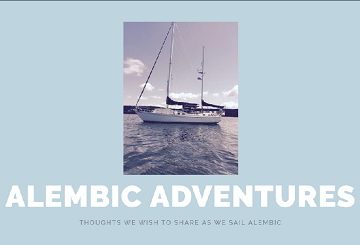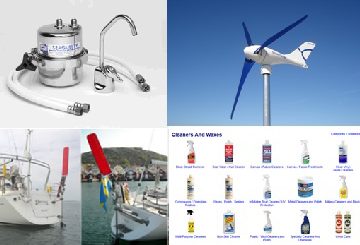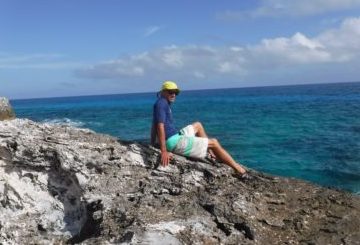
Bill, Helen, George, and Cay together again!

Our travels in Belize with George and Cay
Sharing Belize, possibly our favorite “maybe we will retire here” spot, is so easy. Flights are reasonable, weather is usually perfect in April, there are plentiful islands to explore or tuck away, and the people are wonderfully friendly. So, when Cay and George arrived, a day after Erica and Wes left us, we were ready to continue to play. They had stayed a week on Alembic last year and were eager to revisit their favorite snorkel spots and add more spots to the list.

Our friend Brit’s boat is raising sail

Oops. This boat wasn’t set well and went over in a storm in the marina
Not wanting to waste time in a marina, ten minutes after George and Cay stepped aboard Alembic, we set off. We sailed 23 miles to Colson Cays to find the “magnificient snorkeling” that Captain Freya Rauscher described in her usually accurate Belize Cruising Guide. Either she is crazy, the reef has washed away, or we are blind, because we never found this. No worries, the snorkeling on the west side was interesting enough. We found the blue hole (described accurately in her book) which was grassy and murky, but teeming with life.

murky but beautiful

Oodles of starfish
Setting off early in the morning, we sailed south down the outer reef for spectacular water clarity, reefs galore, and fish just screaming “catch me”! Dropping anchor in the middle of what seemed like the biggest reefs, we snorkeled and shot fish, George with the camera and Bill with the spear. George caught hundreds, and Bill caught three: a trigger (sorry Cay), a lion fish (you’re welcome world), and a hogfish (delicious).

Bill’s yummy Triggerfish

Hogfish
Back on Alembic, we continued south to Tobacco Cay for more excellent snorkeling. Swimming through bizarrely warm water, we found interesting squid, huge spotted eagle rays,

Huge Spotted Eagle Ray
25 tarpon schooling around us, and hundreds of other edible and beautiful fish. No spears here; it’s a preserve.

Sunset at Tobacco

Cay relaxing on our long day of sailing
Sailing through this pass the next morning, I thought of all the creatures we had seen which were now under our keel. Water depths dropped to 700 feet just a few hundred feet from the opening. Sailing southeast sixteen miles to Glover Reef turned out to be a breeze (like my pun?!) George and Cay are never seasick or show any fear of open ocean. Most guests, and also most charter boats, don’t leave the safety of the protected shallow waters inside the reef, but they miss out on this wilder part of Belize.
Our first snorkel, at the Southwest corner of Glover, provided spectacular viewing, but no catching. Bill, the only one who uses a spear, didn’t see the huge hogfish.

Steve, showing off his huge barracuda. We bought his smaller hogfish
Luckily, Steve, a local fisherman fixed us up with his catch, so we didn’t go hungry. That night, we dinghied to Marisol resort to enjoy a drink in the Tiki Bar, and get some local knowledge from Whitney, a Dangriga local, and Zoe, a 29 year old dive master who has lived at this remote resort for years. We enjoyed a moment to celebrate George’s birthday aboard Alembic.

Happy Birthday George
Much of Glover Reef is too shallow for Alembic, but we managed to explore up to Long Cay and Northeast Cay, 6 miles north of the southern entrance, where we came in and spent the first night. A few nail biting moments for me happened as we navigated by sight around the numerous treacherous reefs around this area: “Turn right, now left, now right, quick, okay, I think we can squeeze between those two heads, whatdya think?” Luckily I was wearing a bathing suit, so wetting my pants wouldn’t matter.

Our taxi to the fish
Snorkeling all around Long and Northeast Cays didn’t measure up to the southern end, but we still enjoyed the adventure and the interesting resorts. one resort was set up as a school, and a group of high school students were enjoying the safety of their cage, as the sharks swarmed them.

kids in the safety cage

Cay, enjoying the shark from the safety of the dock

A boring ride back gave us plenty of together time
Our trip west again, back to the protection of the reefs, was uneventful and required motoring to assist the sails. Entering at Southwater Cay, we dropped our anchor nearby and snorkeled the south side of the cut. Snorkeling never gets old, especially when Cay pores over the books to identify every fish, coral, and sea creature, and George hones his photography skills filming and snapping pictures of every new species or activity. When we aren’t snorkeling, we are viewing footage (or stealing Georges photos for my blogs!!) and participatiing in Cay’s classes of “what was this?” and “let’s search for these next time”

A huge Grouper and the elusive Drum
Since we were running low on fresh veggies and fruits, we decided to adventure into Dangriga. Bill stayed aboard Alembic, as the anchorage was completely exposed to any wind or currents, while Cay, George and I ran the dinghy aground OOPS trying to find our way into the river. Once inside the serpentine entrance, we were guided by many locals. Kids on the beach shouted hello, pointing to the town, and at least five men came down to the dock to help us land our dinghy. We needed no help, as I can park a dinghy better than I can park any car at this point, but we accepted their assistance gratefully, knowing that a few bucks would go their way later.
Charles seemed to be in charge, or perhaps they have a system of taking turns. He quickly assessed what we were looking for and walked us around town to find each item. This assistance was truly helpful, as we would never have found the grocery store or the fresh market about a mile away, through dusty windy streets. He arranged for a quick ride back to the dinghy because we ended up with more provisions than we could comfortably carry, and also because poor Charles was wheezing so bad from his emphazema. Back at the dinghy, we paid everyone: the taxi driver, Charles, the “dock guy”. Even though the town was pretty run down, I felt a real sense of community there. Riches don’t buy you the community connections we all hope for.
On to our new favorite spot in Belize: Hideaway Caye. A young couple, Dustin and Kim, bought this tiny mangrove island in Pelican Cays 13 years ago, and after saving their tips from bartending in Key West, began building their home. Now, they rent one small cabana, but make more money serving delicious food and drinks at their open air Robinson Crusoe-like restaurant. Ya gotta go there to fully appreciate it; I can’t possibly describe the jungle/perfection they have created by hand.

Turtles everywhere

Oops, Cay almost sat on the turtle!
Treats abounded the next day. First, a spectacular snorkel at Queen’s, where we swam alongside several huge turtles. Cay almost sat on one by mistake as she surfaced for air while the turtle swam just beneath her. A Belizean fishing boat was anchored, and all hands on deck were cleaning conch to make room on their crowded vessel for more. Tossing the parts overboard caused a traffic jam of fish, shark, turtles, and other creatures to crowd the area and scavenge every morsel raining down from the boat. Acting oblivious to the humans in the area, the sea animals remained focused on their meal, while I tried to focus the camera!

Belizean Fishing Boat
Queens Cay was not safe as an overnight anchorage, as it was too close to the open ocean, so we headed back in the lee of Hatchett cay as the daylight dwindled. Safe on the mooring, we headed into shore for overpriced drinks and a spectacular sunset. This fancy resort reminded me that all sorts of folks enjoy Belize. Honeymoon packages are about $5000 for 6 nights! One beer was about all we could afford, and we had our fantastic meal and a comfortable night on Alembic

Enjoying a fancy resort at Hatchett Cay
After Hatchett, we ventured on to North Long Coco for more glorious snorkeling.

George catching a Jack, ironically, as we entered Jack’s Cay

Bill’s catch at Jack’s
Jacks Cay proved to be an awesome place for the most wildlife. Birds entertained us continuously in the harbor, as they dive bombed the shores for fish, and the fish on the north side of the island were more plentiful than anywhere we had seen. We even saw a manatee which, unfortuneately eluded our camera.

Cay made a great deck hand

Putting George to work as a deck swabby

Captain Bill enjoying watching everyone else work
Reluctantly, we headed for Placentia, via Cary Cay, which meant our two weeks were coming to a close. More adventures are in store for the four of us, I’m sure.

Our Belizean fisherman friends in Placentia




















































































































































